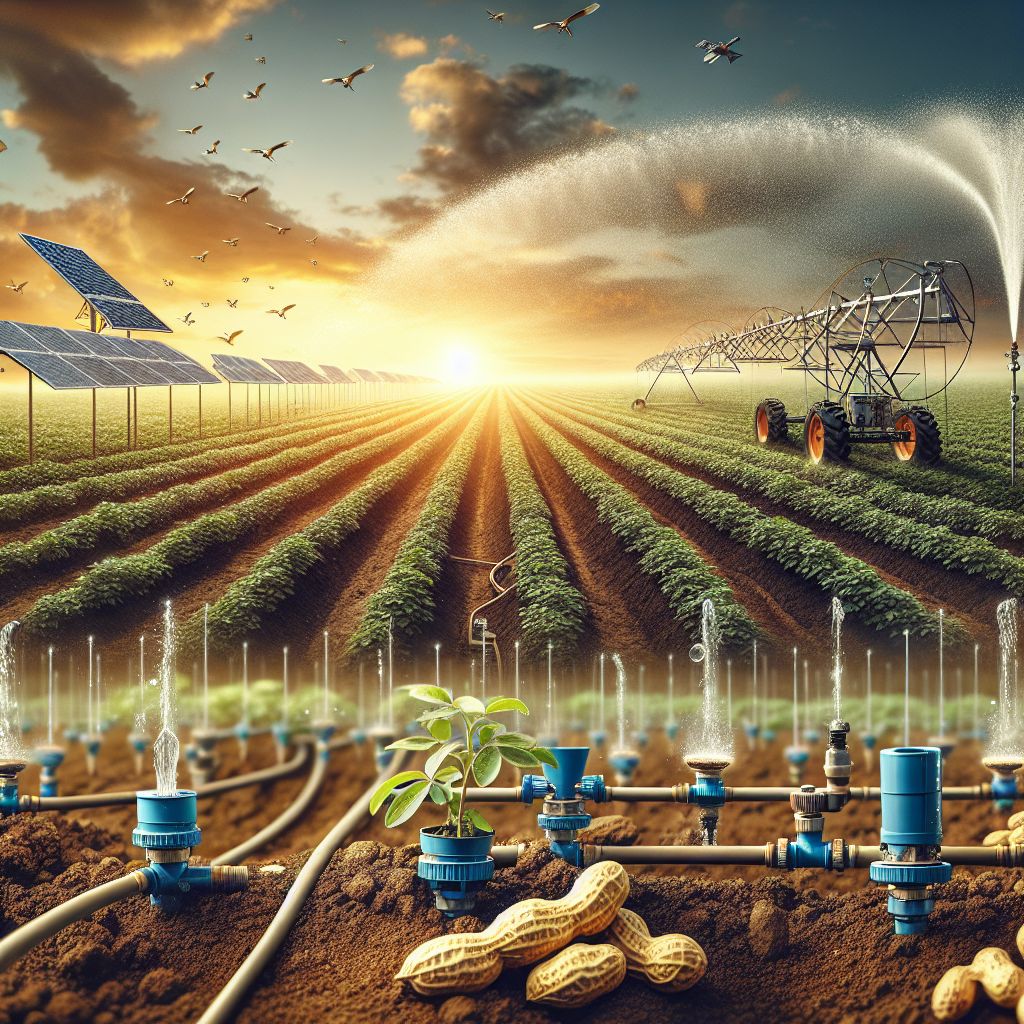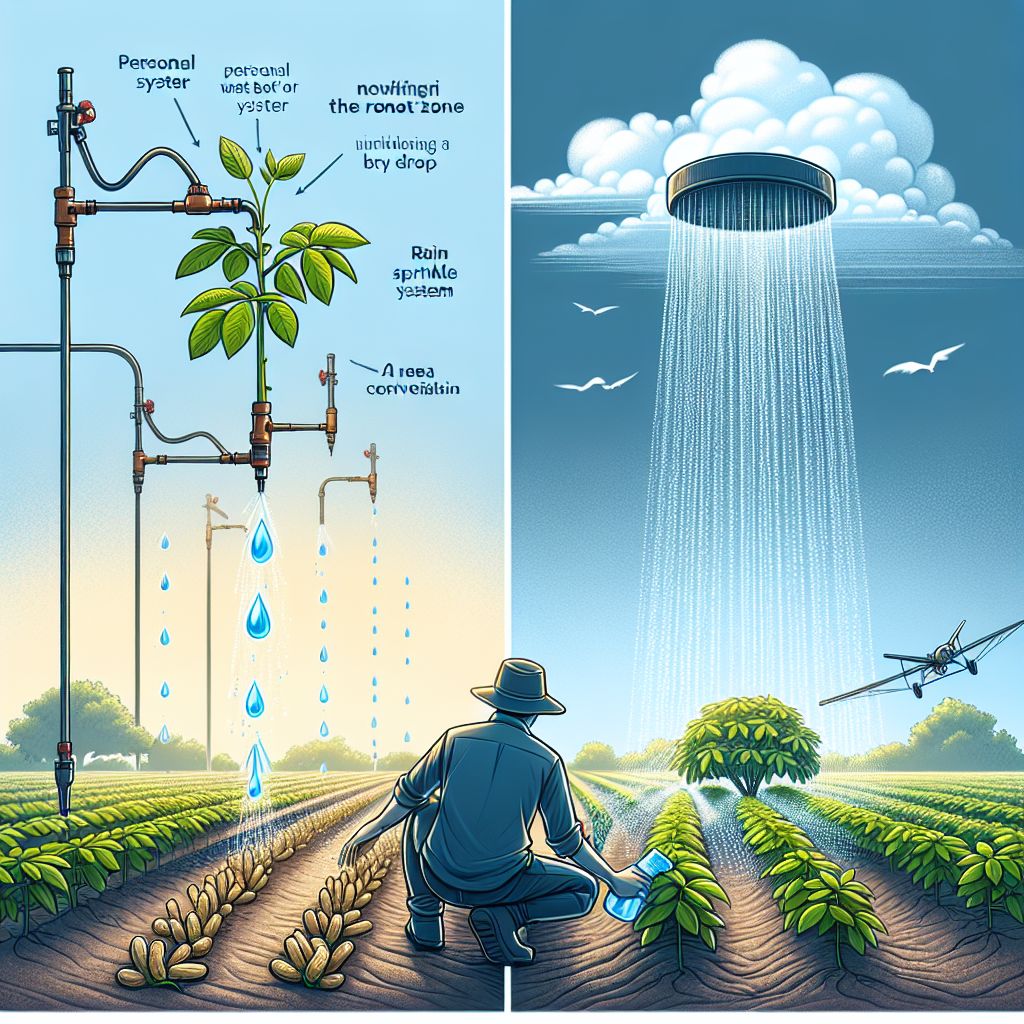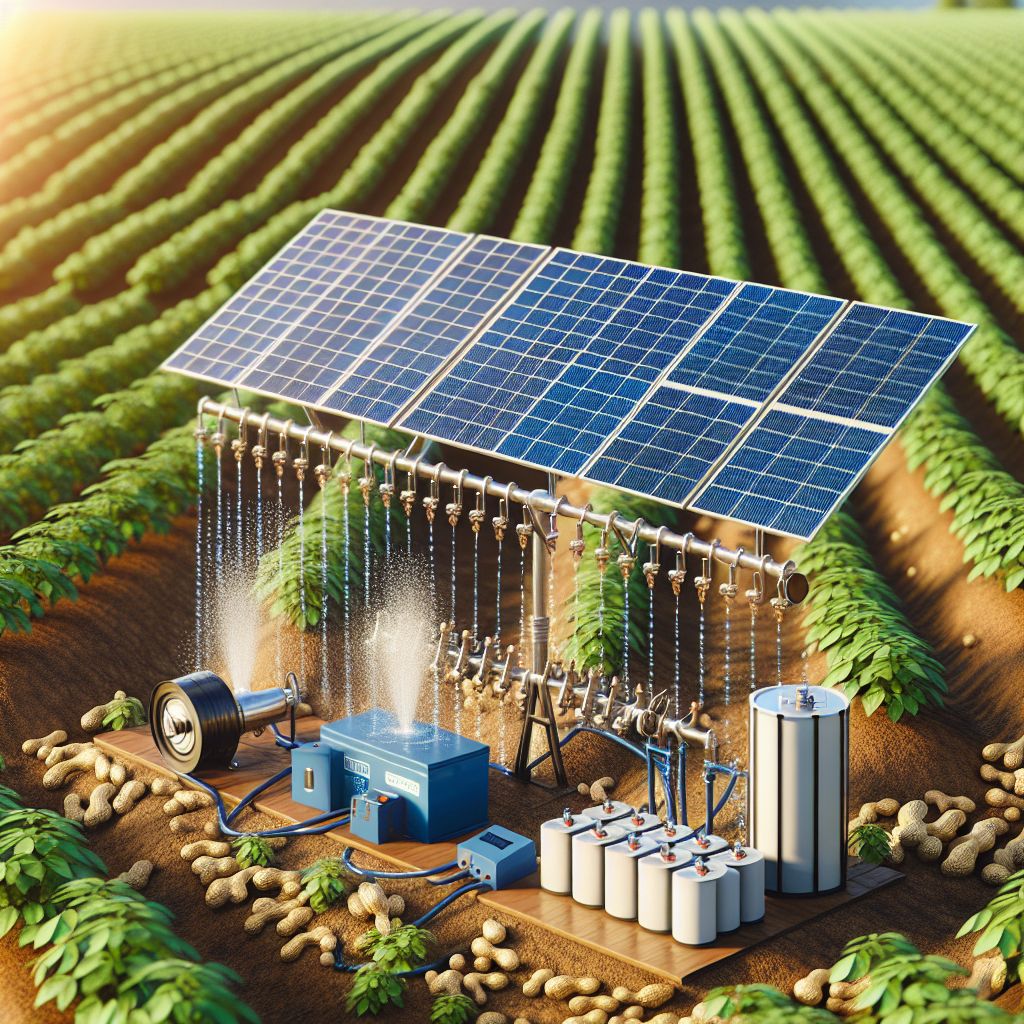
Key Takeaways
Knowing how much water peanut plants need is key to effective watering.
Whether you use drip or sprinkler irrigation depends on many things, including the type of soil and the climate where you live.
Drip irrigation can make watering more efficient and less wasteful by targeting the roots of the plants.
Sprinkler systems can work well in some situations, but they may use more water.
Adding solar power to irrigation systems can make watering even more efficient and can lower energy costs.
Water is to peanut growing what gold is to a treasure hunter—precious and something you want to use wisely. That’s why it’s so important to know how much water peanut plants need. Peanuts grow in a special way, and they need different amounts of water at different times. From the time you plant the seed until you harvest the peanuts, water is key to how well your plants do and how many peanuts you get.

Understanding the Watering Needs of Peanut Plants
Ready to roll up your sleeves and get to work? Metaphorically, that is. We’re here to talk about peanut plants and their unique hydration requirements. Peanuts aren’t just any old crop; their watering needs vary throughout their growth cycle. It’s not as simple as watering them whenever you remember. It’s about knowing precisely when and how much water they need.
Getting to Know the Water Needs of Peanut Plants at Each Stage of Their Life Cycle
To start with, peanuts go through a number of stages: germination, vegetative growth, flowering, pegging, and lastly, maturation. During germination, your peanuts are just starting to sprout, extending their tiny roots, and they don’t require much water. However, once they reach the vegetative growth phase, their need for water begins to increase. They’re developing leaves and need more water to keep up with the growth.
When peanuts start flowering and pegging, they are not just growing, they are starting to produce peanuts. It is important to ensure they have enough water, but not too much, because overwatering can be just as damaging as underwatering. As they mature and get ready for harvest, peanuts need less water. To optimize this process, consider exploring efficient watering solutions for your crops.
Checking Soil Moisture for Effective Irrigation
Monitoring soil moisture is key to achieving the perfect balance when watering. Don’t worry, it’s not as difficult as it seems. You can use instruments such as soil moisture sensors or even perform the classic ‘touch test’—pick up some soil and see if it sticks together. If it’s overly dry, you need to water; if it’s too wet, you should postpone the irrigation.
However, be mindful that peanuts do not thrive in overly wet conditions. Maintain an appropriate water level to prevent root rot and other problems associated with excessive moisture.
When to Water Peanuts for the Best Crop
Watering peanuts isn’t as simple as just turning on the sprinkler. It’s important to water based on the growth stages I discussed earlier. Also, keep an eye on the weather. You’ll want to adjust your watering schedule based on how much rain you’re getting.

Deciding on the Best Irrigation Technique
So, how are you going to get that water to your parched peanuts? There are two main players in the irrigation game: drip and sprinkler systems. Both have their strengths and weaknesses, and the best option for you will hinge on several critical elements.
Drip or Sprinkler?
Think of drip irrigation as providing a personal water bottle for your peanuts. It delivers water directly to the root zone, one drop at a time. This method is incredibly efficient and can save a lot of water, which is beneficial for the environment and your wallet.
On the other hand, sprinkler systems are like having rain whenever you need it. They can cover a large area and are easier to set up. However, they can use a lot of water and may not be as precise as drip systems.
What to Consider When Choosing an Irrigation System
Keep these things in mind when you’re picking out an irrigation system:
Soil Type: Drip irrigation may be more beneficial for sandy soils that drain quickly, as it keeps water where it’s needed.
Topography: Drip systems might be more effective for hilly lands where sprinkler systems could cause runoff.
Water Source: If your water supply is limited, drip systems are the best choice to make every drop count.
Consider your local climate as well. In hot, dry areas, evaporation can take water from your sprinkler system before it even reaches the ground. Drip systems are less affected by evaporation, making them a smarter choice under these circumstances.
This table is comparing the key factors to consider when deciding between a drip irrigation system or a sprinkler irrigation system:
|
Factor |
Drip Irrigation |
Sprinkler Irrigation |
|---|---|---|
|
Water Efficiency |
Highly efficient, delivers water directly to plant roots with minimal evaporation or runoff. 1, 2, 3 |
Less efficient, some water is lost to evaporation and runoff. 3, 4 |
|
Water Usage | ||
|
Plant Health |
Can increase disease risk by wetting foliage. 3 | |
|
Weed Control |
Does not provide weed control benefits. 3 | |
|
Installation |
Relatively easy to install, especially for small areas. 1, 4 |
More complex installation, especially for larger areas. 4 |
|
Maintenance | ||
|
Cost |
More expensive upfront cost, but lower operating costs. 1, 4 |
Lower upfront cost, but higher operating costs. 4 |
|
Flexibility |
Less flexible layout options. 3 | |
|
Suitable for |
Vegetable gardens, flower beds, orchards, vineyards. 1, 3, 4 |

Drip Irrigation: The Efficient Way to Water Peanuts
When it comes to watering peanuts, efficiency is key. You want to deliver the right amount of water, to the right location, at the right time. That’s why drip irrigation is so effective. This system slowly delivers water directly to the base of the peanut plants, right where it’s needed most. It’s all about precision – making sure each peanut plant gets just what it needs, without wasting any water.
Why Drip Irrigation is the Best Choice for Watering Peanuts
Drip irrigation is a real game-changer for peanut farming. It can cut water usage by up to 60% compared to sprinkler systems, which is a big deal in places where water is a precious commodity. But that’s not the only benefit of drip irrigation. Here are a few more:
Watering only the areas near the peanut plant’s roots means weed growth is kept to a minimum.
The risk of leaf diseases, often spread by water splashing on the leaves from sprinklers, is reduced.
It’s possible to fertilize directly through the system, a process known as fertigation, making it even more efficient.
With its targeted approach, drip irrigation also helps you avoid watering the weeds. That’s right, it’s like hanging a ‘do not disturb’ sign on your peanut plants, telling the weeds to go look for a drink elsewhere.
The Cons of Drip Irrigation
However, as with all things, drip irrigation has its flaws. It can be pricier to install at first, and it needs upkeep to ensure the drip lines are free of blockages. Also, if you have animals that enjoy gnawing on stuff, they might develop a taste for your drip lines, which can be quite a nuisance.

Showering Your Peanuts with a Sprinkler Irrigation System
Sprinkler systems are the traditional method of watering crops, and they’ve been in use for a long time. They operate by spraying water into the air, covering a large area as if it were raining. It’s a simple way to water your peanuts, but it’s not always the most efficient.
Using a sprinkler system allows you to water your whole peanut field in a short amount of time, and it’s not too difficult to learn how to use. If your field is flat and doesn’t have any significant slopes, a sprinkler system could work well for you.
A key advantage is that sprinkler systems can be more cost-effective to implement than drip systems. They’re also quite resilient, so you won’t have to be as concerned about animals causing as much harm as they could with drip lines.
Here’s the deal: Sprinkler systems can use a massive amount of water. Because they’re spraying water everywhere, not all of it ends up where it’s supposed to. Evaporation and wind can take that water away, which means you might be watering the neighbor’s field as much as your own peanuts.
Why Sprinklers are a Good Choice for Watering Peanuts Instead of Drip Irrigation Systems
They can water large areas quickly and easily.
They are less expensive to install than drip systems.
They are durable and less likely to be damaged by animals.
Therefore, if you live in a region where water is plentiful and you want to get the job done quickly, a sprinkler system might be your best bet. Just remember that it’s not the most efficient way to use water.
Don’t forget to consider the wind either. If you’ve ever attempted to water your lawn on a breezy day, you know what I mean. The water can land anywhere except your peanuts, which is hardly efficient.
Issues with Using Sprinkler Irrigation Systems for Peanut Cultivation
Despite the popularity of sprinkler systems, they do have some drawbacks when it comes to peanut farming. The most significant problem is the waste of water. Much of the water can evaporate before it even reaches the ground, particularly on hot or windy days. Additionally, there’s the issue of water runoff. If your field isn’t entirely flat, you may find water running off into areas where it’s not needed, leading to more waste.
Another issue is disease. Water on the leaves of peanut plants can create a damp environment that is ideal for fungal diseases to flourish. This can be a significant issue, especially in humid climates where diseases can spread rapidly.

Boosting Irrigation Efficiency with Solar Energy
Picture this: your irrigation system, but powered by the sun. It’s not just a dream. Solar panels can give your irrigation system a serious upgrade. Using solar power, you can operate your drip or sprinkler system without needing to plug into the grid. This translates to reduced energy costs and a more environmentally friendly operation.
How to Use Solar Energy for Irrigation
Using solar energy for your irrigation system is not as complicated as it sounds. All you need are solar panels, a battery storage system, and a pump that can work with solar power. The panels absorb energy from the sun, the batteries keep this energy, and the pump uses this energy to circulate water in your irrigation system.
It’s a wise decision that not only saves you money, but also guarantees your irrigation system will continue to function even during power outages or in remote areas where electricity isn’t easily accessible.
Advantages of Solar-Powered Irrigation for Peanut Cultivation
Here’s why solar-powered irrigation systems are a perfect fit for peanut farming:
Lower Energy Expenses: Solar power can greatly decrease the energy expenses related to pumping irrigation water.
Eco-Friendly: Solar energy is clean, renewable, and lessens your carbon footprint, making your peanut farm more sustainable.
Dependability: Solar systems provide steady power, ensuring your peanuts are watered even when the grid is down.
The best part? The price of solar panels has been decreasing, making this an increasingly affordable option. Plus, there are usually incentives and rebates available to help reduce the initial investment.
For instance, a peanut grower in Georgia fitted his farm with a solar-powered irrigation system, slashing his energy bills by 40%. That’s a considerable amount of money saved, particularly when you think about the long-term advantages.
Thus, if you’re aiming to make your peanut farm more efficient and eco-friendly, solar power might be your best bet. It’s a victory for both your pocketbook and the environment.
Conclusion: Steps to Watering Peanuts Effectively
For healthy peanut plants, water management is key. Understand the unique water needs of the peanut plant at each stage of growth. Use soil moisture checks to determine when to water. Choose a watering method—drip or sprinkler—based on your farm’s specific conditions, such as soil and weather. Drip watering is a good choice for its water-saving and targeted delivery, but it does come with a higher initial cost and requires more maintenance. Sprinkler systems are cheaper to set up and easier to maintain but can lead to more water usage and possible disease spread. Consider adding solar panels to power your watering system to cut energy costs and be more eco-friendly.
FAQs
Effective watering isn’t just about having the right irrigation system; it’s also about understanding the small but important details that can make or break your peanut crop. Here are some common questions that can help you better understand the ins and outs of peanut irrigation:
When should I water my peanuts?
How do I know if my peanuts are getting too much water?
Can I use greywater to water my peanuts?
How can I tell if my solar irrigation system needs to be serviced?
Will I save money if I switch to a solar irrigation system?
When should I water my peanuts?
The optimal time to water peanuts is in the early morning. This gives the water a chance to soak deep into the ground before the sun can cause it to evaporate. Watering in the morning also helps to prevent the spread of fungi and other diseases that can flourish in the warm, wet conditions created by watering in the evening.
How can I tell if I am overwatering my peanut plants?
Overwatering is a common issue, but it’s easy to avoid with a bit of vigilance. Look out for signs like yellowing leaves, wilting (strangely enough), and a general lack of vigor in the plants. Also, regularly check the soil moisture; if it’s consistently soggy, you might be giving your peanuts more water than they can drink up.
Is it possible to use recycled water to water peanuts?
Recycled water can be an excellent resource for watering, but it’s crucial to make sure it’s treated correctly to prevent the distribution of pathogens. Always consult local rules and guidelines before using recycled water for watering purposes.
How do I know if my solar irrigation system needs to be serviced?
Watch for a decrease in water pressure, which could be a sign of an issue with the solar pump or panels. Additionally, if your batteries aren’t holding a charge like they used to, you may need to have it looked at. Make sure to clean the solar panels regularly to keep them working as efficiently as possible.
Will I save money by converting to a solar irrigation system?
Adopting solar power can pay off over time, particularly as solar technology becomes more affordable and you start to see savings on your energy bills. Weigh the upfront costs against the long-term energy savings to see if it’s a good fit for your farm.
Wrapping up, growing peanuts with a water-efficient irrigation system is both an art and a science. By considering the specific needs of the crop, evaluating your local circumstances, and possibly adopting solar technology, you can develop a watering system that is not only efficient but also sustainable. With these tactics, you are well on your way to a generous peanut yield that is environmentally friendly and profitable.







Leave a Reply